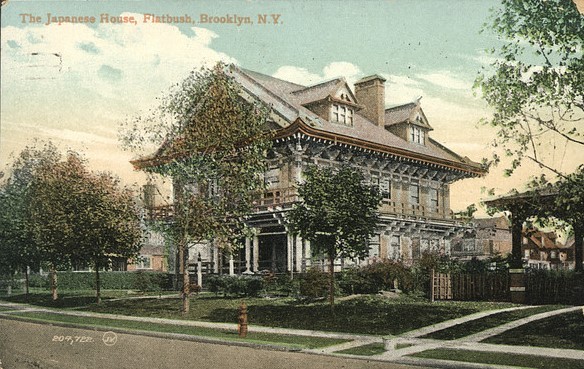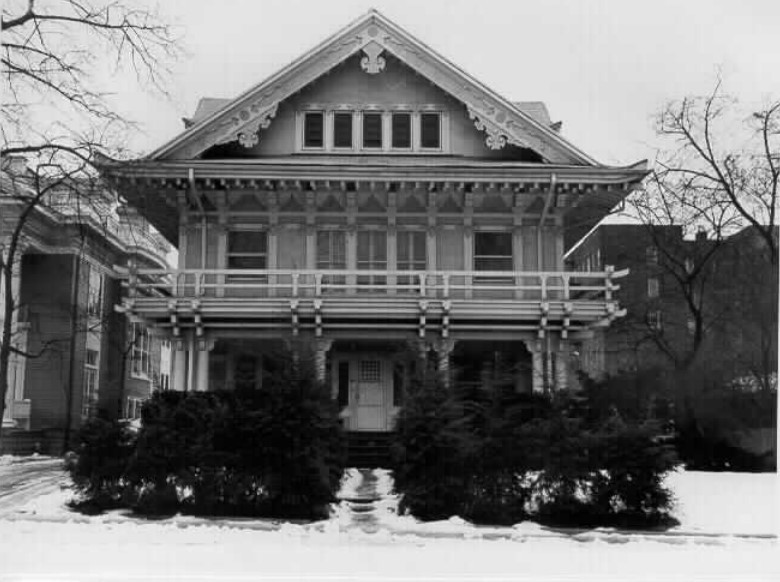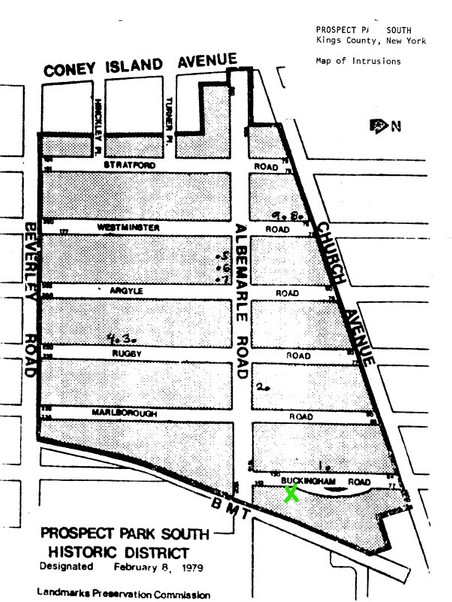Japanese House
Introduction
Text-to-speech Audio
The Japanese style house at 131 Buckingham Rd. was built from 1902 to 1903. Architects Petit & Greene designed the Japanese style house for the speculative developer Dean Alford, who had purchased 50 acres in 1899 to create an upper-class suburban enclave, Prospect Park South. This house was the only one of its kind in the development of Victorian single-family homes, and, while it attracted attention, it was slow to sell. The house cost more to build than any other house in the development, and finally sold in 1906 to Dr. Frederick S. Kolle. The house is within the Prospect Park South Historic District, containing 203 homes and listed in the New York and National Registers in 1983. The house continues to be an attention-getting private residence and retains architectural integrity on the outside and the interior.
Images
Circa 1909 colorized postcard image of the Japanese House

Front (east side) of Japanese House in 1979 photo, NRHP nomination of historic district (Dolkart)

Japanese House (green X) on Prospect Park South Historic District map by NYC LPC in 1979 (Dolkart 1981)

Backstory and Context
Text-to-speech Audio
The streets in the Prospect Park South subdivision were given British names to convey how classy the area was, and there were rules about the size and setbacks of the single-family homes to be built in the neighborhood. The historic district contains parts of these roads: Albemarle, Argyle, Beverly, Buckingham, Marlborough, Rugby, Stratford, and Westminster. The Japanese House is on Buckingham Rd, also known as E. 16th St. on the opposite (south) side of the sunken tracks of the subway, just feet away from the house. Only a handful of later buildings were constructed within the historic district - two low-rise apartment buildings in the 1930s and four houses from the 1950s and 1960s.
The Japanese House is an adaptation of the Victorian Queen Anne style with added Japanese architectural details. The building is box-shaped, covered in stucco, and embellished with Japanese brackets, bargeboards, and an upturned roof. A chrysanthemum, the floral emblem of Japan, is seen on the exterior of the home. The house was pictured on a 1910s postcard and was painted in a more subdued color scheme then, compared to the current rosy pink with green trim.
Developer Dean Alford showed off the Japanese House and raised money for a local cause in 1904 by holding an event at the house. The musicale benefitted the New Avenue C School. Colonel Alexander S. Bacon loaned a number of Japanese objects to decorate the music room for the event. Dr. Frederick S. Kolle was a prominent plastic surgeon. He and his wife, Loretto, a novelist, made the Japanese House their home in 1906. Prior to this, they lived in Brooklyn at 210 Stratford Rd. The Kolles didn't stay in the Japanese House for long. A new family, Mr. and Mrs. Fitch H. Medbury, moved into their new home in the "Japanese bungalow" in September 1909. Herbert Ogden Hyatt and his wife were living in the Japanese House by August 1910 when Mr. Hyatt registered his Packard automobile. In October 1913, their son, William F. Hyatt, got engaged to be married; his sister, Natalie E., got married in a ceremony held at the house in that same month. The Hyatt family still resided there in 1917. The owners of the house in 1925, Louis Steinberger and others, lost the property to foreclosure and the real estate was offered at public auction. Mollye Meskin, an Adelphi College student, was a resident of the Japanese House in 1932. A student at Colgate University in Hamilton, New York, Noel Rubinton, had a Brooklyn home address of 131 Buckingham in 1942.
Mr. and Mrs. Harry E. Woods lived in the Japanese House in 1951 when a newspaper caption for a photo of the house mistakenly attributed its first owners as the Japanese consul and the wood as being imported from the Far East. In 1951, the three-story house of 12 rooms was painted blue and gray with white trim. The Japanese House has been owned by one family for over four decades and has retained much of its original interior details.
Sources
Anonymous. "For School Athletic Fund." Flatbush Weekly News and Kings County Record (Brooklyn) March 26th 1904. 3-3.
Anonymous. "Changes of Residence." Brooklyn Life (Brooklyn) September 18th 1909. 22-22.
Anonymous. "First Registrations Under New Auto Law." Brooklyn Daily Eagle (Brooklyn) August 8th 1910. 19-19.
Anonymous. "Brooklyn Society." Brooklyn Daily Eagle (Brooklyn) October 2nd 1913. 7-7.
Anonymous. "Flatbush." The Chat (Brooklyn) October 11th 1913. 66-66.
Anonymous. "Midwood." The Chat (Brooklyn) September 22nd 1917. 52-52.
Anonymous. "Foreclosures: Supreme Court, Kings County." Standard Union (Brooklyn) April 29th 1925. 2-2.
Anonymous. "News Staff Elected." Times Union (Brooklyn) April 8th 1932. 10-10.
Anonymous. "Personals." Brooklyn Daily Eagle (Brooklyn) October 29th 1942. 18-18.
Anonymous. "Brooklyn - International City: Strictly Oriental." Brooklyn Daily Eagle (Brooklyn) July 15th 1951. 25-25.
Dolkart, Andrew S. NRHP Nomination of Prospect Park South Historic District, Brooklyn, N.Y. National Register. Washington, DC. National Park Service, 1981.
Long Island Business Directory. The Long Island Business Directory. Brooklyn, NY. Brooklyn Directory Office, 1912.
NYC Landmarks Preservation Commission. Designation Report, Prospect Park South Historic District, New York, NY, LP-0979. NYC Government, 1979.
Upington, George. Upington's Brooklyn Street Directory and Guide. Edition Pocket. New York, NY. George Upington, 1904.
Brooklyn Public Library Digital Collections (public domain): https://www.bklynlibrary.org/digitalcollections/item/db85cf76-ec62-422d-927a-ef8235e684b3
New York State Cultural Resource Information System (NYS CRIS): https://cris.parks.ny.gov/Default.aspx
NYS CRIS: https://cris.parks.ny.gov/Default.aspx
